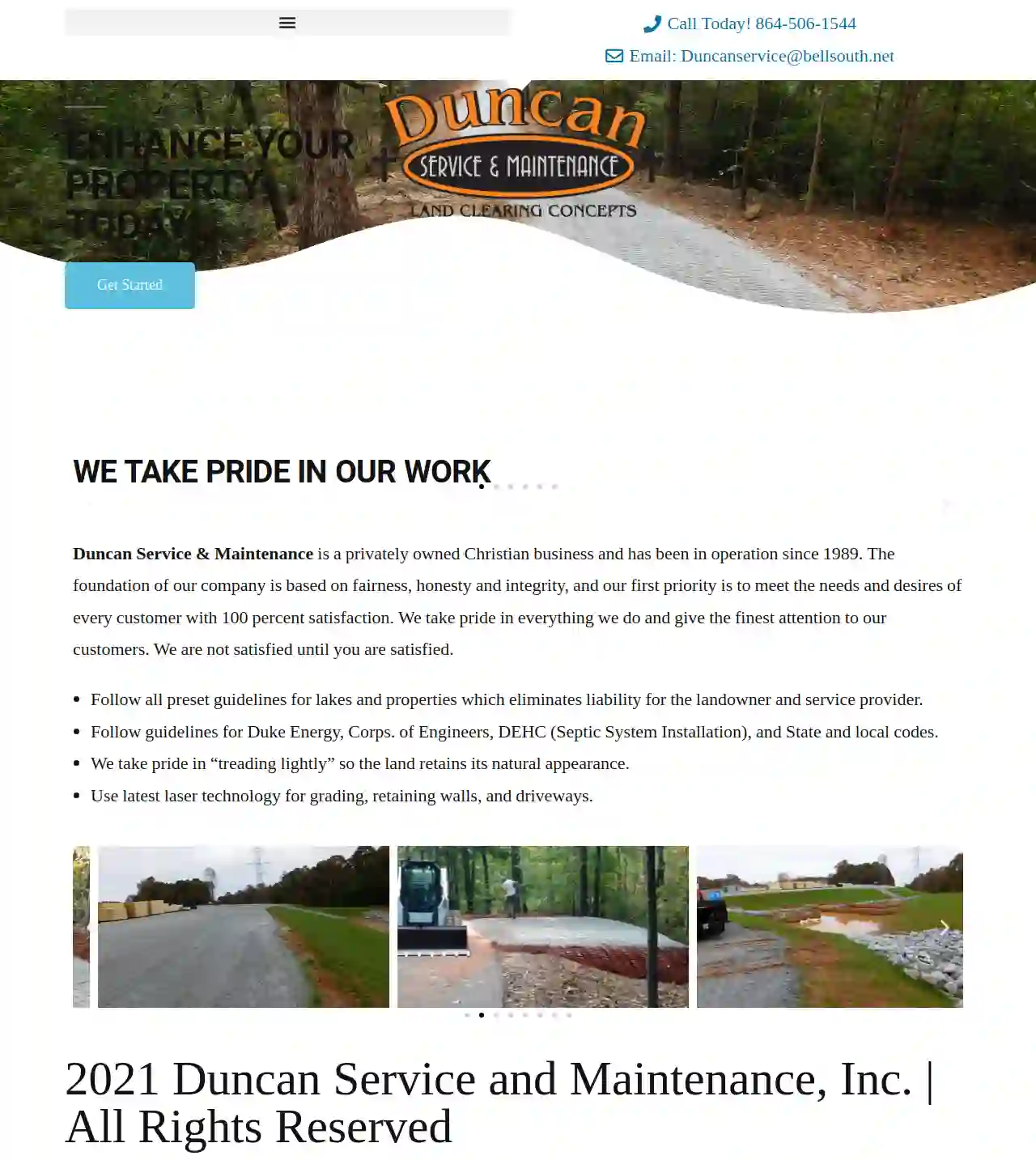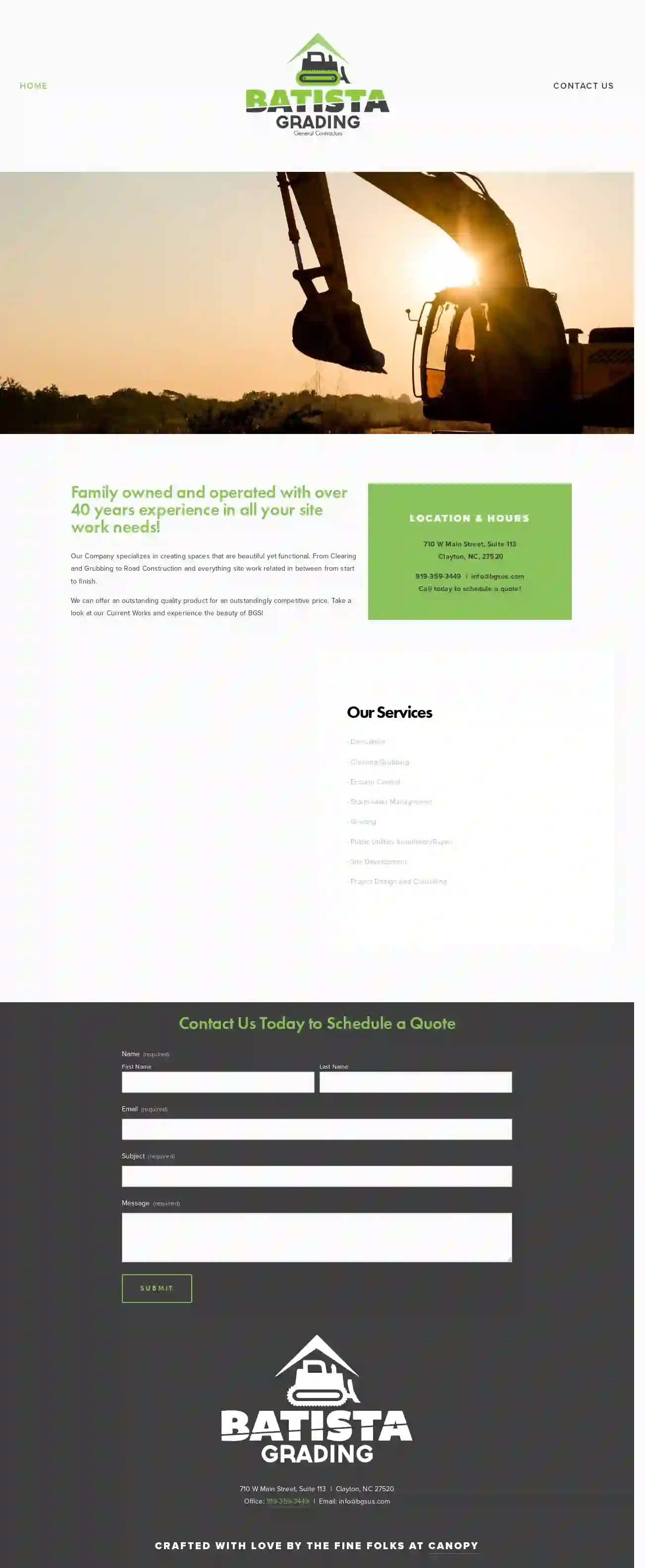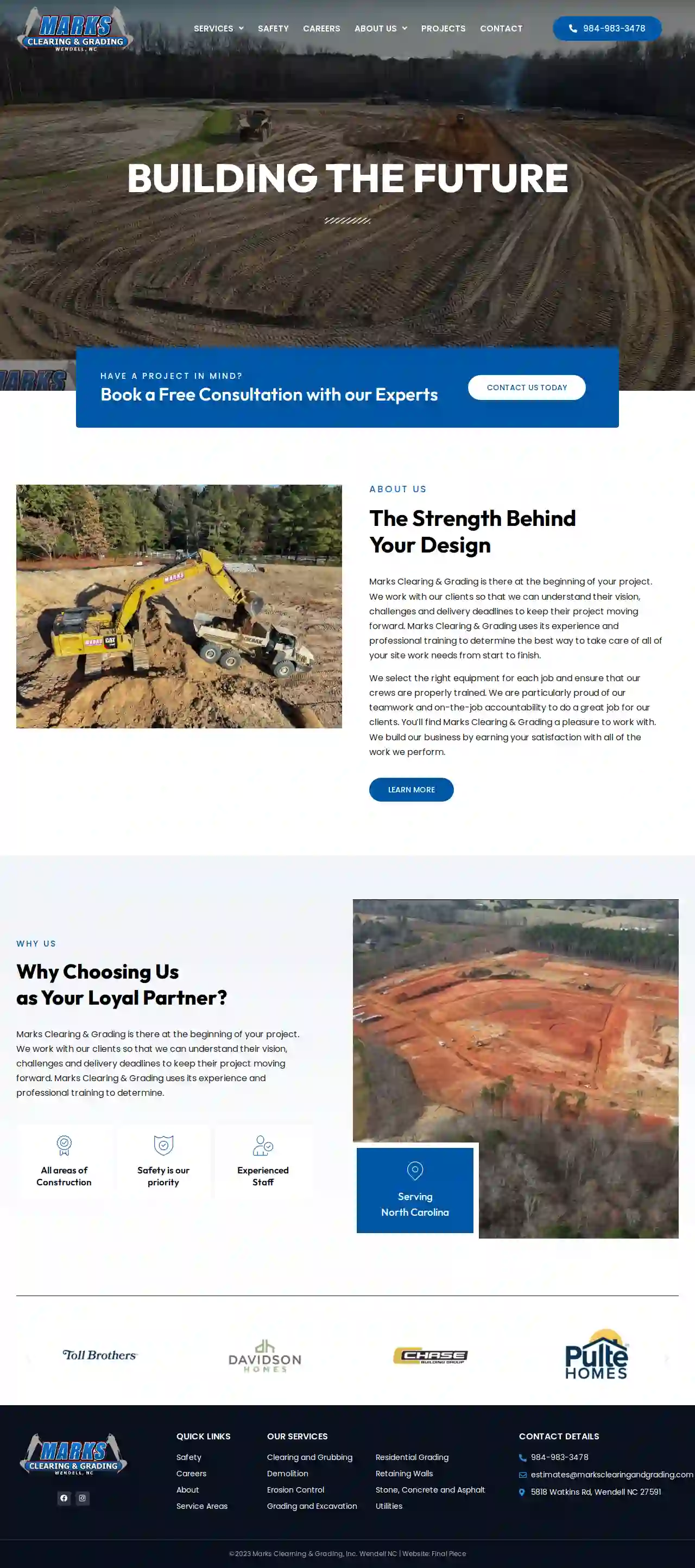Demolition Contractors Pleasant Garden
Find top Demo Contractor in Pleasant Garden
Get multiple Local Demolition Contractors quotes for your project today! Compare profiles, reviews, accreditations, portfolio, etc... and choose the best service.

Charah Solutions, Inc.
2.912 reviews12601 Plantside Drive, Louisville, 40299, USAbout Us With over 35 years of experience, Charah Solutions is a leading provider of mission-critical environmental services and byproduct recycling to the power generation industry. Our Approach Charah Solutions is committed to providing sustainable solutions that meet the needs of our customers and the environment. We believe in a collaborative approach, working closely with our clients to develop customized solutions that are both effective and cost-efficient. Mission, Vision & Values Our mission is to provide innovative and sustainable solutions that protect the environment and enhance the quality of life for our communities. Our vision is to be the leading provider of environmental services and byproduct recycling in the power generation industry. Our values are safety, integrity, teamwork, innovation, and sustainability. Management Team Charah Solutions is led by a team of experienced professionals who are dedicated to providing our clients with the highest level of service. Our management team has a proven track record of success in the environmental services industry. Safety Safety is our top priority at Charah Solutions. We are committed to providing a safe and healthy work environment for our employees, contractors, and the communities in which we operate. We have a comprehensive safety program that includes training, procedures, and equipment to ensure the safety of all our stakeholders. Environmental Compliance Charah Solutions is committed to environmental compliance. We are licensed and permitted to operate in all of the jurisdictions in which we work. We have a strong environmental management system that ensures we meet or exceed all applicable environmental regulations. Trade Associations & Partners Charah Solutions is an active member of several trade associations, including the National Coal Association, the American Coal Ash Association, and the American Society of Civil Engineers. We also partner with a number of other organizations to promote sustainable practices and environmental stewardship.
- Services
- Why Us?
- Gallery
Get Quote
KCI Associates of North Carolina, P.A.
4.36 reviewsCharlotte, USCreating a more interconnected, livable world At KCI, we apply knowledge, determination and skill to improve, support, develop, implement and build a society that connects us not only to our clients, but to each other. Explore All Capabilities KCI is a leading provider of engineering, planning, and construction services. We offer a wide range of services to meet the needs of our clients in the public and private sectors.
- Services
- Why Us?
- Gallery
Get Quote
Whitestone Construction
51 reviewsJacksonville, Florida, USWhitestone Construction Whitestone Construction started as a local family business with a culture of respect and quality service not only to our customers, but also to our employees. We understand that by respecting and enabling our employees, we provide only the best service to our clients. Our offices are located in Jacksonville, Florida and North Charleston, South Carolina. Whitestone Construction is licensed and bonded with over 50 years of experience in all aspects of both residential and commercial site development. Our Mission Provide outstanding services and solutions with integrity, expertise and quality workmanship, all the while respecting and protecting the environment and our client's interests. Our Values We believe in honesty, integrity, and transparency in all our dealings with our clients. We value teamwork, professionalism, and continuous learning and improvement.
- Services
- Why Us?
- Our Team
- Gallery
Get Quote
Ray Gunter Dump Trucking
4.640 reviews7720 Tallahassee Avenue, Jacksonville, 32208, USRay Gunter Trucking, Inc. - Your Trusted Hauling Partner in Jacksonville, Florida Since 1981, Ray Gunter Trucking has been a reliable name in the Jacksonville area, providing expert hauling services for both residential and commercial projects. We understand the importance of timely and efficient delivery, ensuring your materials arrive on schedule and ready for your next project. Whether you're a homeowner tackling a landscaping project or a contractor managing a large construction site, we've got you covered. Our team is dedicated to providing exceptional service and delivering your materials with care. We offer a wide range of materials to meet your needs, including: Fill Dirt Sand Topsoil Mulch Various types and sizes of Stone Limestone Granite Crushed Asphalt (milling) Crush Crete Baserock Mix (rough base material) Judy Mix (1/2 topsoil/1/2 sand) And more… We're also happy to mix custom blends to meet your specific project requirements. Contact us today for a free phone estimate and let us help you get your project off to a smooth start.
- Services
- Why Us?
- Gallery
Get Quote
Duncan Service & Maintenance, LLC
56 reviewsAsheville, USDuncan Service & Maintenance: Enhancing Your Property Since 1989 Duncan Service & Maintenance is a privately owned Christian business with a strong commitment to fairness, honesty, and integrity. Since 1989, we've been dedicated to exceeding customer expectations and delivering 100% satisfaction. We take pride in every project, ensuring meticulous attention to detail and customer satisfaction. Our commitment to excellence extends to adhering to all preset guidelines for lakes and properties, eliminating liability for both landowners and service providers. We also follow guidelines set by Duke Energy, the Corps. of Engineers, DEHC (Septic System Installation), and State and local codes. We believe in "treading lightly" to preserve the natural beauty of the land. Our team utilizes the latest laser technology for grading, retaining walls, and driveways, ensuring precision and quality in every project.
- Services
- Why Us?
- Gallery
Get Quote
Hanks Land Management, LLC
516 reviews394 Herman Brooks Rd, Belton, 29627, USAbout Us Hanks Land Management is a family-owned and operated business offering Land and Farm Clearing and Grading. Our team can provide top-quality work backed with excellent customer service. We believe our clients deserve the best from start to finish. Our team is dedicated and we deliver cost-effective solutions for your land management needs.No job is too big or too small Why You Should Choose Hanks Land Management Choosing Hanks Land Management for your land and farm needs in Anderson County, South Carolina, will be a decision you won’t regret. Our comprehensive suite of services caters to both residential and commercial clients, ensuring all aspects of land clearing and development are covered. From lot clearing, septic installations, and fence line clearing to more specialized tasks such as grading, driveway installation, and the creation of food plots, we’re equipped to handle projects of any size. Our team is skilled in access road clearing, fence building, stump removal, mulching, and clearing landscape boundaries, ensuring your property is managed efficiently and effectively.Serving the vibrant communities of Greenville, Greenwood, and the broader Upstate of South Carolina, Hanks Land Management is committed to delivering high-quality services that meet the unique needs of our clients. We understand the importance of completing projects quickly and accurately, which is why we leverage our expertise and state-of-the-art equipment to achieve optimal results. Whether you’re preparing a new construction site, enhancing the accessibility of your land, or installing new infrastructure, our team is here to ensure your vision comes to life with precision and professionalism.
- Services
- Why Us?
- Our Team
- Testimonials
- Gallery
Get Quote
Hrustic Brothers Inc
6498 Fayal Dr. S #1, Jacksonville, 32258, USAbout Hrustic Brothers High-quality construction materials, attentive customer service, and comprehensive project services have made Hrustic Brothers a leader in aggregate supply and trucking since 2003. Based in Jacksonville, Florida, our team provides the First Coast with dump truck and hauling services, fill material and aggregate supply, concrete demolition and recycling, and roll-off dumpsters for waste concrete. Trust Hrustic Brothers to lay the groundwork for your next project, and we’ll show you what decades of experience can do for you.
- Services
- Why Us?
- Gallery
Get Quote
Batista Grading Inc
51 reviews710 W Main Street, Suite 113, Clayton, 27520, USBatista Grading & Site Utilities A family-owned and operated business with over 40 years of experience in all your site work needs! We specialize in creating spaces that are beautiful yet functional. From clearing and grubbing to road construction and everything site work related in between, we handle it all from start to finish. We offer outstanding quality products at outstandingly competitive prices. Take a look at our Current Works and experience the beauty of BGS!
- Services
- Why Us?
- Gallery
Get Quote
Marks Clearing and Grading
4.114 reviews5818 Watkins Rd, Wendell, 27591, USBuilding the Future Marks Clearing & Grading is there at the beginning of your project. We work with our clients so that we can understand their vision, challenges and delivery deadlines to keep their project moving forward. Marks Clearing & Grading uses its experience and professional training to determine the best way to take care of all of your site work needs from start to finish.We select the right equipment for each job and ensure that our crews are properly trained. We are particularly proud of our teamwork and on-the-job accountability to do a great job for our clients. You’ll find Marks Clearing & Grading a pleasure to work with. We build our business by earning your satisfaction with all of the work we perform. Why Choosing Us as Your Loyal Partner? Marks Clearing & Grading is there at the beginning of your project. We work with our clients so that we can understand their vision, challenges and delivery deadlines to keep their project moving forward. Marks Clearing & Grading uses its experience and professional training to determine. All areas of Construction Safety is our priority Experienced Staff Serving North Carolina
- Services
- Why Us?
- Gallery
Get Quote
Baker Construction
51 reviews900 North Garver Road, Monroe, 45050, USBuilding Better across All Measures of Excellence Baker Construction is the nation’s leading commercial concrete construction contractor. By honoring our legacy and living The Baker Way, we strive to build a better future for everyone who comes in contact with our company. Our History Baker Construction was founded in a small house in Oxford, Ohio, in 1968 — built by the hands of Dan Baker and his brothers, Ken and Jim. Dan learned the cement finisher’s trade from his grandfather, Elmer Baker, and he grounded the business on the principles Elmer instilled in him: excellence, hard work, service, and integrity. To this day, those same principles steer our company and inspire our co-workers. Our Core Ideology Everything we do at Baker Construction is rooted in The Baker Way. It’s the philosophy that defines how we work with our clients and treat our co-workers. The Baker Way ensures our goals, decisions, and actions focus on building a better future for everyone who comes in contact with Baker Construction. COMMUNITY IMPACT We take pride in our work, in keeping our word, and in doing our part to support the communities where we live and work. Our Advisory Board Baker Construction is a subsidiary of Baker Construction Enterprises, the nation’s largest specialty concrete contractor. Also founded by Dan Baker, Baker Construction Enterprises is guided by a Board of Advisors with deep roots in our industry.
- Services
- Why Us?
- Gallery
Get Quote
Over 22,076+ Excavation Companies on our platform
Our excavation experts operate in Pleasant Garden & surroundings!
ExcavationHQ has curated and vetted the Best Excavation Contractors in and around Pleasant Garden. Find a reliable contractor today.
Frequently Asked Questions About Demolition Contractors
- 'Can I see proof of your licensing and insurance?' Verify their credentials and coverage.
- 'What experience do you have with projects like mine?' Ensure they have relevant expertise.
- 'Can you provide references from past clients?' Check their reputation and customer satisfaction.
- 'What are your safety protocols?' Prioritize contractors who emphasize safety.
- 'How will you handle hazardous materials?' Ensure they have proper procedures for asbestos or lead abatement.
- 'What is your timeline for completing the project?' Understand the project duration.
- 'How will you manage noise, dust, and debris?' Discuss mitigation measures for minimizing disruption.
- 'What are your payment terms?' Clarify payment schedules and any required deposits.
- Site Security: Secure the demolition site with fencing and warning signs to prevent unauthorized access.
- Personal Protective Equipment (PPE): Workers should wear appropriate PPE, including hard hats, safety glasses, gloves, and steel-toe boots.
- Hazardous Material Removal: Properly identify and remove asbestos, lead paint, or other hazardous materials before demolition begins.
- Utility Disconnections: Disconnect all utilities, such as electricity, gas, and water, before demolition.
- Controlled Demolition Techniques: Employ controlled demolition methods to minimize risks and ensure the structure comes down safely.
- Dust Control: Implement dust suppression measures, such as water spraying or misting, to reduce airborne particles and protect air quality.
- Emergency Planning: Have an emergency plan in place, including communication protocols and evacuation procedures, in case of unforeseen events.
- Implosion: Using explosives to collapse a structure inwards rapidly. Suitable for large buildings in open areas.
- Wrecking Ball: Swinging a large steel ball to impact and break down the structure. Effective for bringing down walls and other solid elements.
- High-Reach Demolition: Utilizing specialized excavators with extended arms and demolition attachments for dismantling tall structures piece by piece.
- Selective Demolition: Removing specific parts of a building while preserving other sections. Often used in renovation projects.
- Deconstruction: Carefully dismantling a building to salvage reusable materials, reducing waste and environmental impact.
How do I find demolition contractors near me?
What questions should I ask a demolition contractor before hiring them?
What are the safety precautions for demolition?
What are the different types of demolition?
How do I find demolition contractors near me?
What questions should I ask a demolition contractor before hiring them?
- 'Can I see proof of your licensing and insurance?' Verify their credentials and coverage.
- 'What experience do you have with projects like mine?' Ensure they have relevant expertise.
- 'Can you provide references from past clients?' Check their reputation and customer satisfaction.
- 'What are your safety protocols?' Prioritize contractors who emphasize safety.
- 'How will you handle hazardous materials?' Ensure they have proper procedures for asbestos or lead abatement.
- 'What is your timeline for completing the project?' Understand the project duration.
- 'How will you manage noise, dust, and debris?' Discuss mitigation measures for minimizing disruption.
- 'What are your payment terms?' Clarify payment schedules and any required deposits.
What are the safety precautions for demolition?
- Site Security: Secure the demolition site with fencing and warning signs to prevent unauthorized access.
- Personal Protective Equipment (PPE): Workers should wear appropriate PPE, including hard hats, safety glasses, gloves, and steel-toe boots.
- Hazardous Material Removal: Properly identify and remove asbestos, lead paint, or other hazardous materials before demolition begins.
- Utility Disconnections: Disconnect all utilities, such as electricity, gas, and water, before demolition.
- Controlled Demolition Techniques: Employ controlled demolition methods to minimize risks and ensure the structure comes down safely.
- Dust Control: Implement dust suppression measures, such as water spraying or misting, to reduce airborne particles and protect air quality.
- Emergency Planning: Have an emergency plan in place, including communication protocols and evacuation procedures, in case of unforeseen events.
What are the different types of demolition?
- Implosion: Using explosives to collapse a structure inwards rapidly. Suitable for large buildings in open areas.
- Wrecking Ball: Swinging a large steel ball to impact and break down the structure. Effective for bringing down walls and other solid elements.
- High-Reach Demolition: Utilizing specialized excavators with extended arms and demolition attachments for dismantling tall structures piece by piece.
- Selective Demolition: Removing specific parts of a building while preserving other sections. Often used in renovation projects.
- Deconstruction: Carefully dismantling a building to salvage reusable materials, reducing waste and environmental impact.